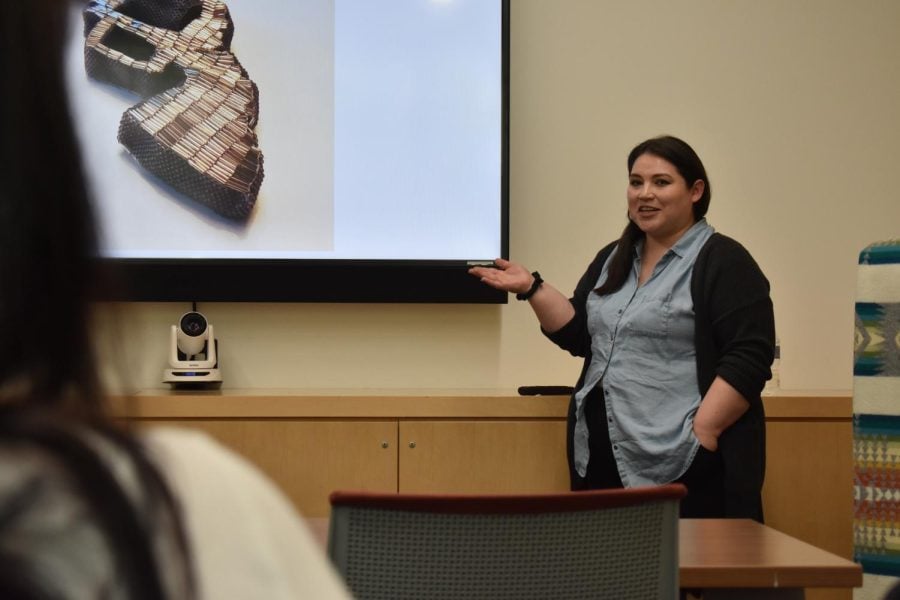Artist in Residence Noelle Garcia uses art to explore Indigenous identity, family history and recovered narrative
Jessica Ma/Daily Senior Staffer
Artist in Residence Noelle Garcia spoke about her drawings, paintings and sculptures, which touch on themes of identity, family history and recovered narrative.
April 27, 2023
The Center for Native American and Indigenous Research hosted a public talk with its 2023 Artist in Residence Noelle Garcia on Wednesday evening.
Garcia, a multidisciplinary artist from the Klamath, Modoc and Paiute tribes from Oregon and Nevada, is currently based in the Chicago area. Her art focuses on themes of identity, family history and recovered narrative.
During her talk, Garcia walked the audience through a presentation of some of her artworks, and described the experiences and sentiments behind them. Through art, Garcia described her childhood experiences growing up with her father who was incarcerated. He often sent drawings in his letters to her, she recalled.
“I grew up understanding drawing as this expression of affection,” Garcia said. “Having gone through all the art schools, affection is something we don’t talk about in art.”
Garcia shared a drawing from her father’s funeral, which she translated into a painting — something she does frequently. The painting is intentionally abstract, she said, so it can be a place to play with space, lines and paint.
CNAIR Associate Director of Community Outreach and Engagement Pamala Silas, an enrolled member of the Menominee Tribe of Wisconsin and descendant of the Oneida Tribe of Wisconsin, said Garcia weaves her life stories into her artwork.
“Art is embedded in our everyday life,” Silas said. “It was wonderful to hear the stories and see how it transcends everything about who she is. There’s a freedom she expresses in trying new things.”
To select the artist in residence, CNAIR partnered with the Center for Native Futures, a non-profit organization dedicated to creating a Native and Indigenous gallery space in the city of Zhegagoynak or Chicago.
Center for Native Futures co-founder Chris Pappan, who is of Osage, Kaw and Cheyenne River Sioux descent, said the center strives to invest in Indigenous artists by sharing their work with a broader audience.
“They asked us to put forward an artist, so we thought Noelle would be the perfect choice,” Pappan said. “I’m getting to know her as a person and as an artist.”
Silas said CNAIR aims to “carve out a space” for Garcia as she pursues her artistic endeavors.
While at NU, Garcia — an assistant professor of humanities and fine arts at National Louis University who previously taught at the School of the Art Institute of Chicago, Homan Square — has been invited to art classes to conduct guest critiques, she said.
Garcia, who loves to paint, described the process as similar to nature. Paint doesn’t have any edges, she said, which makes it engaging to work with.
In addition to painting, Garcia also creates soft sculptures, for instance, by covering bottles of pills with beads. Indigenous people are more likely to have heart disease and diabetes, which research stipulates derives from generational trauma, Garcia said.
“If you use Indian health care, sometimes they’ll send you these giant bottles of pills,” Garcia said. “People will bead around pens, around lighters. I thought, ‘Well, I can bead around bottles.’”
Garcia said she feels frustrated about the way art is taught in American education. Academia centers Eurocentric ideas of what art should be and what art history is, she said.
Education is used as a means of erasure, Garcia added, as institutions give positions based on academic credentials, which isn’t representative of artistic knowledge.
“You’re not going to give this amazing grandma who does amazing beadwork a professor position, because she doesn’t have a degree,” Garcia said. “But why is she going to get a degree in Indigenous studies when she’s lived it and knows more than some of the academics?”
Garcia also emphasized the importance of mentorship. When she works with other Indigenous artists, she aims to support and uplift them, she said — a practice she wants to see other educators adopt.
For Garcia, learning and teaching are a part of her practice. Indigenous history contains missing pieces due to boarding schools and relocation, Garcia said. Learning practices such as basket making involves going to museums and meeting with elders, she said.
“My dad has not been able to learn these things, because he was forced into a boarding school. But I can learn it for him,” Garcia said. “I can teach my kids how to do it, and I can teach my art students how to do it.”
Correction: A previous version of this story misstated Noelle Garcia’s employment status at National Louis University. The Daily regrets the error.
Email: jessicama2025@u.northwestern.edu
Twitter: @JessicaMa2025
Related Stories:
— ‘The land is our relative’: NAISA hosts second annual Pow Wow on Earth Day
— 30 Days of Indigenous programming celebrates Native American and Indigenous heritage
— NAISA commemorates 158th anniversary of the Sand Creek Massacre, reiterates demands to NU



